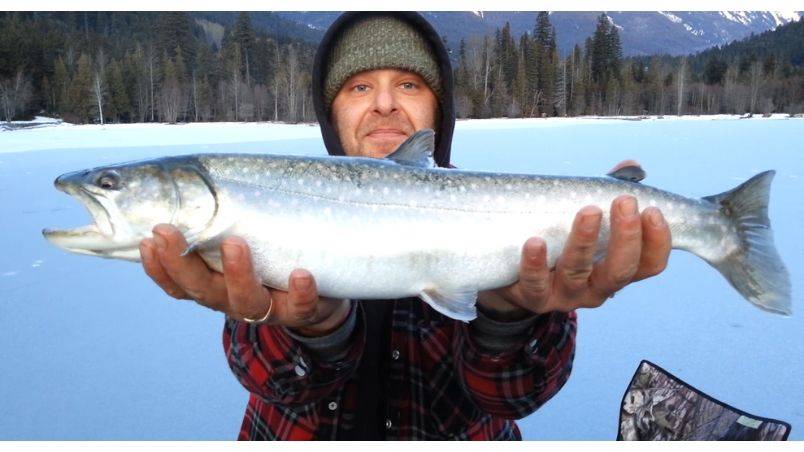When the warmer weather hits, there’s nothing like hitting the open water for some fresh catch. But even in winter, fishing enthusiasts can enjoy the thrill of the hunt through ice fishing. Not only is it a fun way to enjoy the great outdoors, but it also adds another activity to your winter itinerary that just about anyone can enjoy, and which, perhaps best of all, ends with a deliciously fresh meal for baking or grilling back home.
As accessible as ice fishing is, for your first try out, it’s recommended to set out with a guide to show you the ropes. Brad Knowles is one such guide. The owner of Pemberton Fish Finder (https://pembertonfishfinder.com), Knowles has been doing ice fishing tours since the Winter Olympics of 2010 in Whistler. “We were looking for something to complement our business and make it a year-round destination for fishing,” he says. “Whistler is known for powder snow and mountains, but people come for weeks at a time and their legs will only allow them to ski for a few days at a time, so this is another great winter activity that’s also low-impact, safe, and fun for all ages and abilities.”

Pemberton starts their ice fishing season mid-December, which carries through to the end of March, when they swap over to the rivers for cutthroat and steelhead fishing. Where he fishes, Knowles says it’s not uncommon to see large trout. “We predominantly fish for rainbow, cutthroat and bull trout. It’s world class fishing,” says Knowles.
Key to Pemberton’s ice fishing experience is the remoteness of the location. “We head to a frozen lake, in the middle of nowhere,” says Knowles. “All the equipment we use is portable, and we leave nothing on the ice when we’re done, so people on our tours always feel like they’re the first ones there.”
Still, the location can vary depending on the weather. “Elevation plays a big role in extending our season,” says Knowles. “Being on the west coast, we do get a fair amount of precipitation; if that persists it can change to warmer weather. But water doesn’t really affect ice; sunshine is more an issue, though we don’t really get a lot of sun in winter because the days are short. We pick our lakes accordingly. If we have a lot of sun and warmer temperatures, we’ll pick a lake that’s shaded.”
As for the fishing itself, the location differs each time. “It depends on where the fish are,” says Knowles, who particularly enjoys ice fishing at Lost Lake in Whistler, and Blackwater Lake in Pemberton. “Sometimes we’ll go right to the middle of the lake, if that’s where we think it’s happening. Otherwise, the shoreline. It really depends on the species you’re chasing; you govern yourself accordingly,” he says.

Not everyone on the tour is a seasoned fishermen, according to Knowles, who says he has visitors come from all over the world. “We do two trips a day, depending on the time of year. The first one will start around 9 or 10am, and the next around noon,” he says. “On a full day tour, we’ll bring the barbecue along and cook a fresh catch. We’re known for our gourmet trout lunch. People say they’re the tastiest they’ve ever had.”
Pemberton brings portable ice huts that come in a variety of sizes depending on the number of people in your group. “It’s amazing the difference between being out in the open and being in one of our ice huts,” says Knowles. “They take the sun energy and produce quite a bit of heat. You can fish with your jacket off inside the hut,” he says, noting that guides will bring propane heaters on cooler days. “If it’s nice out, we’ll fish outside, so you can look around. Inside the hut on a bright day, though, you can see the fish eating your hook.”

Ice fishing isn’t limited to ice hut experiences, however. Donovan Pearase of Blackwater Cats Outfitter (www.blackwatercats.com) in Winnipeg Manitoba, runs ice fishing tours January to March. “Lake Winnipeg is one of the top destinations for trophy walleye,” says Pearase. “Word got out about 10 years now, and it became the go-to destination.”
While he says his company is one of the biggest fishing outfitters on Lake Winnipeg, they prefer to avoid ice huts. “We don’t do shacks; we don’t fish in ice houses,” says Pearase, explaining that they prefer to keep moving, mostly by foot though they also use snow machines and 4×4 trucks to get around. “Were’ modern ice fishing guys; we don’t set up in one spot and fish. If it’s really cold we’ll fish out of insulated shelters, but the key to fishing is mobility, so we’re always moving around.”
There is some skill involved in the ice fishing itself. “The whole point is to fish from an 8-inch hole, and some of the fish are pretty big,” says Knowles. “It’s ideal to be in an area you know where fish will be feeding and create something they will want to come and eat. We don’t want to give away our secrets, but we do use a lot of electronics, fish finders and underwater cameras to help us find the best spots.”
Ice fishing differs in a few other ways as well. “Ice fishing rods are typically 24 inches in length, so you can sit up overtop your pole,” says Knowles. “You drop the hook down the hole and fish in a jigging motion. Some people fish with bait, but we find jigging attracts more fish.”
Pearase admits it can be difficult to find fish and tackle them on your own. “My one piece of advice is to make sure you’re properly equipped,” he says. “If you need to use snowmobiles to get around the ice, make sure everything is strapped down and packed tightly, or everything will break apart and get banged up and damaged.”

Safety, of course, comes first. “Throughout the winter, we’re fishing on 12 to 24 inches of ice; you could drive a car or truck on it.” says Knowles, who cautions to test the ice as you go, and stay away from open ice. “We test the ice regularly, making holes and measuring thickness. We share a network of information between our guys. If we find a spot that’s questionable, we relay that to our guides and through social media.”
And the right gear is critical. “First and foremost, you’re dressed for sub-zero temperatures,” says Knowles. “I always recommend wearing a toque and parka and waterproof winter boots. If you’re a person who gets cold easily, bring extra layers. We provide things to keep people warm such as ice huts and heaters, but even that sometimes isn’t enough. You’re standing on a frozen lake.”
Gear can be rented or purchased from local outfitters and sporting goods shops. “The staff at our is very knowledgeable and we’ll give tips and offer all the ice fishing equipment you could need to go on your own,” says Knowles.
While some people bring their own equipment to Blackwater Cat’s guided expeditions, they can also provide the gear, which includes an auger for drilling holes, tent, heater, chairs, rods, bait, tackle, lures and fishing electronics. “We use a thing called a flasher to find the fish,” says Pearase. “You can watch the fish come in in real time, and see everything that’s going on under the hole.”
Knowles insists that fishing can be enjoyed by everyone, but he does recommend going with someone who knows what they’re doing, especially on your first time out. At Pemberton Fish Finder, Knowles likes to get participants involved in all aspects of the experience, including making the hole. “We’ll use an electric auder or gas auder,” he says. “We made a swap last year and brought on some extra electric augers—it allows us to drill a hole in the hut without emissions and it’s quieter too. All the birds don’t disappear out of the trees when we use it,” he laughs.
For all its differences, ice fishing is still wildly enjoyable and growing more popular every day. “It used to be a bucket list fishing trip, but around here people are active and outdoorsy. It’s definitely growing in popularity,” says Knowles. “It’s great for families and large groups; we get a lot of stags and stagettes. It’s a fun thing to do in winter.”
“Ice fishing has been at the height of popularity the last few years,” Pearase seconds. “As long as the fish keep coming, the popularity will continue.”
What you’ll need:
- Auger or ice drill
- Fishing rods and fishing tackle
- Portable heater
- Winter-appropriate wear
- Local fishing licence
Where to go:
Thanks to its long, cold winters, Canada has plenty of excellent ice fishing spots coast-to-coast. Here are just a few popular destinations, and some of the local tour guides and outfitters who can help you on your first time out.
Lake of the Woods, Ontario/Manitoba
Sitting on the Canada/U.S. border, Lake of the Woods is one of the largest freshwater lakes, offering great fishing year-round. A popular ice fishing destination, it’s known for Walleye, but also offers opportunities to catch northern pike and lake trout as well.
Guides/rentals:
Ryan Haines
Darcy Cox
Lake Simcoe, Ontario
Lake Simcoe hosts some of the biggest tournaments in North America, including the annual Canadian Ice Fishing Championship. Perch are a major draw here, though pike, lake trout, and whitefish can also be had. Known as the “ice fishing capital of Canada,” an hour and a half from Toronto, it has plenty of ice huts too available for rent.
Guides/rentals:
Ice Fishing Outfitters
JS Fish Huts
Lake Nipissing, Ontario
One of the largest lakes in Ontario, Lake Nipissing has a surface area of over 330 square miles. Located next to North Bay, it offers plenty of walleye, as well as pike and perch, along with numerous ice fishing bungalows and lodges you can rent.
Guides/rentals: FishBayMarina.com AnglersHaven,ca
Cold Lake, Alberta/Saskatchewan
Located on the Alberta-Saskatchewan border northeast of Edmonton, Cold Lake is popular for lake trout, though it’s also home to pike, whitefish and perch. Cold Lake is so deep that it often doesn’t freeze until late December or early January, making February and March the best times to fish.
Guides/rentals: TravelAlberta.com IceFishingAlberta.com
Great Slave Lake, Northwest Territories
You’ll be in for a treat at Great Slave Lake. With the greatest lake depth in North America, trout here can grow up to 60 pounds, though Arctic greyling, northern pike and whitefish can also be found here. The ice fishing season runs long—from December until May, and you can take guided tours out of Yellowknife.
Guides/rentals: BlueFishServices.ca
An editor with 15-plus years in the publishing business, Catalina Margulis’ byline spans travel, food, decor, parenting, fashion, beauty, health and business. When she’s not chasing after her three young children, she can be found painting her home, taming her garden and baking muffins.













